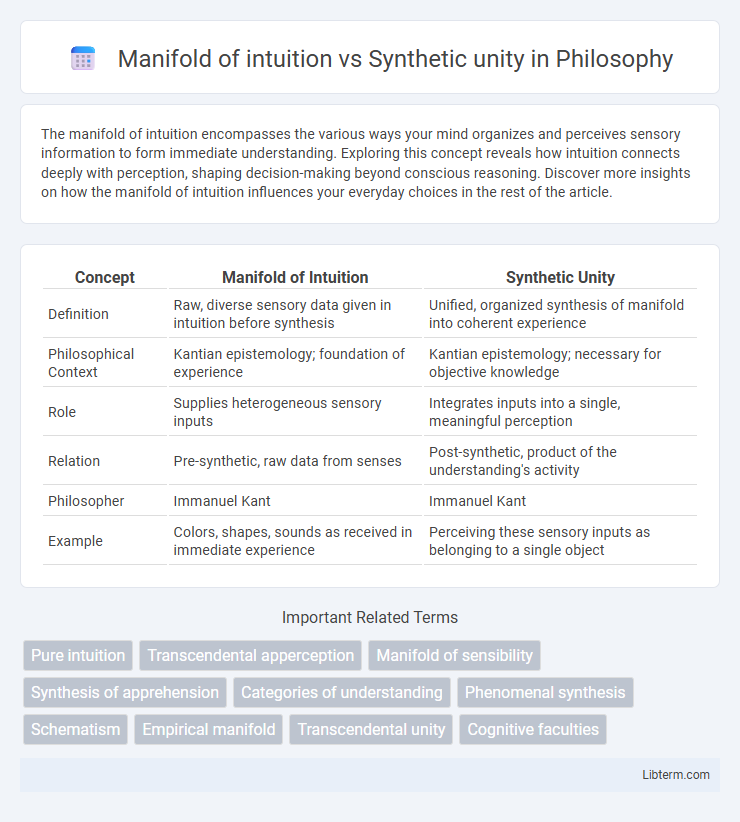The manifold of intuition encompasses the various ways your mind organizes and perceives sensory information to form immediate understanding. Exploring this concept reveals how intuition connects deeply with perception, shaping decision-making beyond conscious reasoning. Discover more insights on how the manifold of intuition influences your everyday choices in the rest of the article.
Table of Comparison
| Concept | Manifold of Intuition | Synthetic Unity |
|---|---|---|
| Definition | Raw, diverse sensory data given in intuition before synthesis | Unified, organized synthesis of manifold into coherent experience |
| Philosophical Context | Kantian epistemology; foundation of experience | Kantian epistemology; necessary for objective knowledge |
| Role | Supplies heterogeneous sensory inputs | Integrates inputs into a single, meaningful perception |
| Relation | Pre-synthetic, raw data from senses | Post-synthetic, product of the understanding's activity |
| Philosopher | Immanuel Kant | Immanuel Kant |
| Example | Colors, shapes, sounds as received in immediate experience | Perceiving these sensory inputs as belonging to a single object |
Understanding the Manifold of Intuition
The manifold of intuition refers to the diverse sensory data that the mind organizes to form coherent experiences, grounded in Kantian philosophy where intuition is the immediate representation of objects. Understanding this manifold involves recognizing how sensory inputs, both spatial and temporal, are synthesized by the mind to create unified perceptions before conceptual processing. This synthesis is key to experiencing objects as continuous and structured rather than fragmented sensations.
Defining Synthetic Unity
Synthetic unity refers to the mind's capacity to actively combine diverse sensory inputs into a coherent, unified experience, enabling the construction of meaningful knowledge beyond mere empirical data. It involves the spontaneous synthesis of the manifold of intuition--raw sensory information--under the guiding framework of the transcendental unity of apperception, which ensures self-awareness and consistency in cognition. This defining feature of Kantian epistemology highlights how the understanding shapes perception by synthesizing heterogeneous intuitions into a single, comprehensible representation.
Historical Context: Kant’s Contributions
Kant's critical philosophy introduced the concepts of the manifold of intuition and synthetic unity as foundational to human cognition. The manifold of intuition refers to the raw, sensory data received through empirical experience, while synthetic unity organizes this data into coherent knowledge through the active synthesis of the mind. This distinction revolutionized epistemology by demonstrating how knowledge arises from the interplay between sensory input and the cognitive structuring faculties, a breakthrough in the Enlightenment's quest to understand perception and understanding.
The Role of Sensibility in Cognition
The manifold of intuition refers to the raw sensory data received through sensibility, forming the diverse inputs that the mind organizes into coherent experience. Synthetic unity involves the active process by which the understanding unites these sensory manifolds into a single, unified cognition or concept. Sensibility plays a crucial role in cognition by providing the foundational empirical content that the understanding synthesizes, enabling knowledge to arise from the interplay of sensory intuition and conceptual thought.
From Disparate Intuitions to Unity
Manifold of intuition refers to the diverse sensory data that the mind receives, which are inherently scattered and raw. Synthetic unity is the cognitive process that organizes these disparate intuitions into a coherent, unified experience by applying concepts and categories. This transition from manifold of intuition to synthetic unity is essential for forming coherent knowledge and conscious experience.
Mechanisms of Synthesis in Thought
The manifold of intuition refers to the diverse sensory data provided by experience, which the mind organizes through synthetic unity, the process of combining these sensory inputs into a coherent representation. Mechanisms of synthesis in thought involve the active role of the transcendental imagination and the understanding, which apply rules and categories to unify this manifold into meaningful concepts. This synthesis is essential for generating the unity of apperception, enabling self-consciousness and coherent cognition.
The Relationship Between Intuition and Understanding
The manifold of intuition represents the raw sensory data that the mind receives, while synthetic unity refers to the understanding's ability to synthesize this data into coherent experiences. Intuition supplies the diverse appearances, and understanding processes these elements through concepts to form judgments. The relationship between intuition and understanding is essential for cognition, as intuition provides the content and understanding organizes it into meaningful knowledge.
Implications for Epistemology
The manifold of intuition represents the raw, sensory data manifold provided by experience, while synthetic unity refers to the active, unifying function of the mind that organizes this manifold into coherent knowledge. This distinction implies that epistemology must account for both the passive reception of information and the mind's synthetic role in constituting objective knowledge. Understanding this dual process challenges traditional notions of knowledge as mere reflection, emphasizing instead the creative synthesis inherent in cognition.
Critiques and Alternative Perspectives
Kant's concept of the manifold of intuition refers to the raw sensory data that the mind organizes through the synthetic unity of apperception, which synthesizes this input into coherent experience. Critics argue that this framework underestimates the active role of perception by treating intuition as primarily passive and challenge the strict separation between intuition and conceptual synthesis. Alternative perspectives, such as phenomenology and cognitive science, emphasize the dynamic interplay between sensory input and conceptual frameworks, suggesting a more integrated process of experience formation beyond Kant's rigid distinctions.
Contemporary Relevance of Kantian Concepts
The manifold of intuition and synthetic unity remain foundational in contemporary cognitive science and philosophy, influencing theories of perception and knowledge synthesis. Advances in neuroscience underscore how sensory data (manifold) are integrated into coherent experience (synthetic unity), echoing Kant's insights on the mind's active role in shaping reality. Modern artificial intelligence also leverages these concepts to enhance machine learning models that synthesize disparate inputs into unified understanding.
Manifold of intuition Infographic

 libterm.com
libterm.com